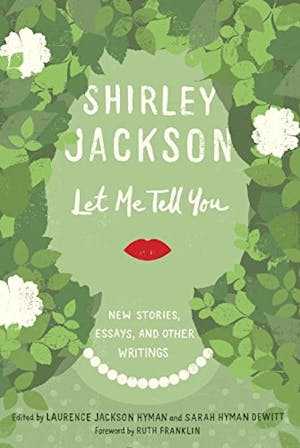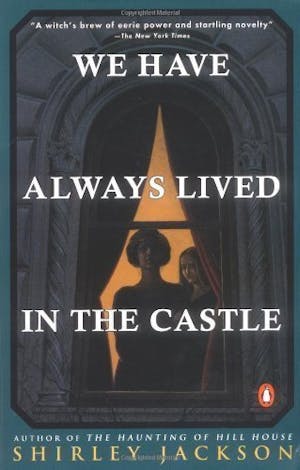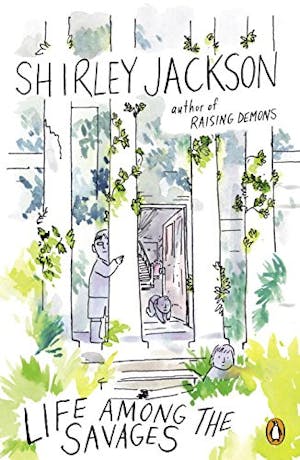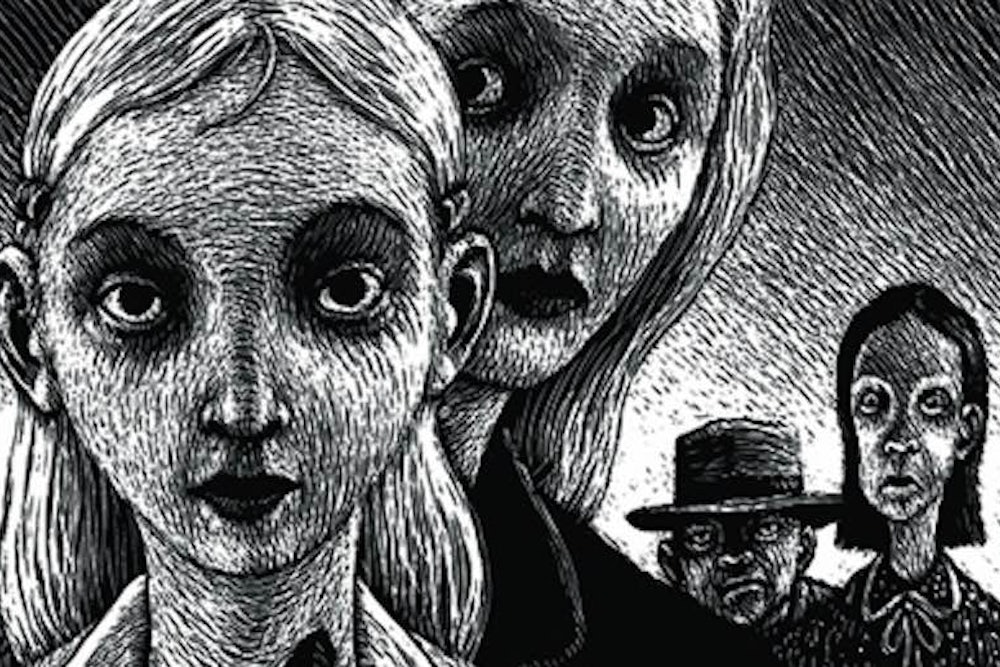“Let me tell you about this girl,” a fourteen-year-old declares breathlessly, “she’s prettier than I am, but she’s my best friend. … Her name’s Hilda. … I try to do a lot of the things she does, but of course she’s always better.” The main thing Hilda and her friend do together, the girl tells us, is secretly ride on street cars “to some part of town where the common people live.” There, they follow strangers, play pranks, and tell lies with potentially ruinous consequences.
“How was that?” asks Hilda, after one particularly successful lie. “Ghastly,” her friend replies—“which is of course our word meaning pretty wonderful.”

So goes the title story in Let Me Tell You, Random House’s new collection of (mostly) previously unpublished work by Shirley Jackson, the American novelist and short story writer best known for “The Lottery” (a story about a charming New England town that, every so often, stones one of its citizens to death). Its contents include many pieces of fiction of varying length and quality, some of Jackson’s essays, a few portraits of family life, and even some of Jackson’s own writing about her work. It is one of at least three Shirley Jackson–related releases coming out this year (the fiftieth anniversary of her death) and is part of a concerted effort by Penguin Random House to put Jackson back in front of the reading public.
Together with Jackson’s two very funny memoirs of family life—Life Among the Savages and Raising Demons—this most recent round of Jackson’s work conjures up a cozy picture of Jackson as a friendly neighborhood spinner of horrors, comfortably ensconced in her loving if somewhat chaotic family (population: one mother, one father, four children, one dog, countless cats). This image is also encouraged by the marketing of the books (“SHIRLEY JACKSON CONFRONTS THE MOST VEXING DEMONS YET: HER CHILDREN,” reads the back of my copy of Raising Demons).
Even Jackson’s protestations to the contrary in a short essay called “The Real Me” (also included in Let Me Tell You), seems at first like a reinforcement of Jackson as a friendly neighborhood witch, performing harmless spells and playing at danger, right up until she cheerfully takes the credit for breaking another woman’s bones. “I am tired of writing dainty little autobiographical things,” she begins,
I live in a dank old place with a ghost that stomps around in the attic room we’ve never gone into (I think it’s walled up), and the first thing I did when we moved in was to make charms in black crayon on all the door sills and window ledges to keep out demons, and was successful in the main. … My most interesting experience was with a young woman who offended me and who subsequently fell down an elevator shaft and broke all the bones in her body except one, and I didn’t know that one was there.

There’s a reason that Jackson has been—and is likely to remain—in the class of writers who require fierce advocates to keep her work alive. Her horror is domestic; it takes place in the familiar world of the kitchen, the family, and known and loved objects. It unsettles too much to be read comfortably. When you finish a story, it follows you afterward and sinks into the walls of your own home and routine—and that’s before you get to Jackson’s bleak view of people in general. In her last novel, We Have Always Lived in the Castle, danger comes not only in the form of poisoned sugar but intense familial love and attachment to home.
“When I wash dishes,” Jackson writes in another essay from Let Me Tell You, “I stare into the dishpan and at my own hands, which are the only alien things in the dishwater, the only things that don’t rattle.” Coming as it does in the midst of an ode to her kitchen sink, it can be easy to miss Jackson’s confession that she does not feel at home in her home. (In fact, she is often savagely aware of the people who, unlike herself, fit into the world without discomfort—in one story, a woman notices “with an edge of viciousness” two girls who hold “their teacups exactly right.”) Within Jackson’s fiction, the domestic world becomes heavy with double meaning, dimly perceived ritual, and secret substitution.
The innocent-seeming young girls who voyeuristically go slumming call their actions “ghastly” because they enjoy saying the opposite of what they mean and because those actions are ghastly. They speak a double language where both sides are true. In another story, a young man stays in a cabin with a harmless-seeming old woman and slowly becomes involved in a ritual of human sacrifice. A man becomes convinced he’s being stalked, only to discover (too late) that his wife is in on the plot. A woman listens to a friend complaining about an irritating stranger, only to realize she is hearing herself described. The familiar opens up to reveal something we would have all preferred not to know.
It’s in the family writings that we appear to be given the world more or less as it is—no dark surprises, no witches, no stonings, just loving chaos. But in Life Among the Savages and Raising Demons, the trick is that the world has already been opened up to reveal not what we are afraid to see, but what we hope to see. Jackson’s own life was not the cheerful mess that she described, but she wanted it to be. Perhaps unsurprisingly, a woman who wrote so charmingly of family life and so bleakly of life in general had a home life that was—at best—troubled.

While an undergraduate in the 1930s at Syracuse University, the young Shirley Jackson met fellow student Stanley Hyman, who had read some of her work in the college paper and thought very highly of it. She then married him, against the will of her family (because he was Jewish) and his (because she wasn’t). Hyman would go on to become a critic at The New Republic and The New Yorker, eventually becoming an instructor at Bennington College in Vermont. From that initial meeting onward, he remained a champion of Jackson’s work, insisting that she find time to write and helping her to get published. They would have four children together. (Two of them, Laurence Jackson Hyman and Sarah Hyman Dewitt, are the editors of Let Me Tell You.)
In Jackson’s memoirs, Hyman is depicted as a somewhat absent-minded father who is often buried in his work and exasperated with the state of their home and the messiness of their lives. (In one story, as the rest of the family endeavors to accommodate all of their many pets, Stanley can be heard “pushing his desk across the study door.”) Every so often, he has interactions with other women that make Jackson jealous, but he is always innocent and often unaware.
In the flesh, however, as depicted in Judy Oppenheimer’s 1988 biography of Jackson, Private Demons, Stanley Hyman was more than absent-minded. He viewed family life as Jackson’s responsibility, down to the smallest details, and they would get into vicious fights. (In Private Demons, a neighbor recalls watching a heavily pregnant Jackson struggle uphill, her arms full of groceries and mail: “He was about to go down and offer her a hand when Stanley burst out of the house and ran down the street to meet her. But … instead of relieving her, Stanley carefully removed the mail from her hand and trotted back up the street.”) He was, in addition, serially unfaithful. After Jackson died, he remarried within the year.
What’s important to note here, however, is that Jackson’s portrayal of Stanley Hyman is loving and honest; she portrays him as a limited person whose hurtful actions do not stem from active malice. Stanley is selfish, but not cruel, something that can be said of no one in Jackson’s fiction. In each moment and in each object, Jackson retains the ability to see the world as if it were something else. Just as she does not invent the hidden violence within everyday life, she also is not sugarcoating her family. They are all limited people who are barely, and mostly through great love, able to make it one day to the next without destroying one another.
Life Among the Savages and Raising Demons are each a good place to begin for those who have never read any Shirley Jackson and are, perhaps, a little daunted by her fiction. Let Me Tell You, on the other hand, is for the already-converted fan, who will be delighted to read so many new stories and essays. The greatest attraction is the 15 essays, which touch on subjects as diverse as the travails of being married to a book critic (“book reviewing is just nothing for a healthy young girl to be married to”), Samuel Richardson (“no small action is consummated in less than ten pages”), poltergeist-bearing postcards (“I think it is simply too much for any one house to have poltergeists and children”), and clowns.
It’s the essay about clowns that is the most endearing piece in Let Me Tell You and, in, some ways, a key to her work. “Almost everyone remembers,” she writes, “with that same longing, a moment when a conclusion of superlative importance emerged from the actions of the pathetic little man who was so funny.” A clown, Jackson posits, is distinguished by his costume, by his apparently thoughtless actions, and by his inability to speak. A clown is also detached from the cares of the world. As she carefully places the clown outside of human speech and concerns, she turns the question around—what are people to a clown?
“They wear a distinctive dress,” [a clown] might say, “usually copied from other people. They seem to be futilely resisting a complexity of life far too great for them, they never seem to have any rational motive for their behavior. And they’re so pathetic they make you cry, but above all”—and here, if he were a true clown, there would be an exaggerated gesture of despair—“they’re unbelievably, irresistibly funny.”
Humor and despair, bound up together here, are both ways of seeing the world that bring to light its double meanings and its contradictions. Both demand a discomfort and displacement in the world as it is. In Jackson’s fiction and in her life, they often devolved, one into the other. But as she wrote in her journal before she died, “laughter is possible laughter is possible laughter is possible.” That may seem a thin assertion. But as you read her stories, you understand the possibility of laughter keeps most of us from a very long fall. And, despite her early death and her uneasy life, it kept Jackson up, too, long enough to show the rest of us that the world really is—unbelievably, irresistibly funny.
